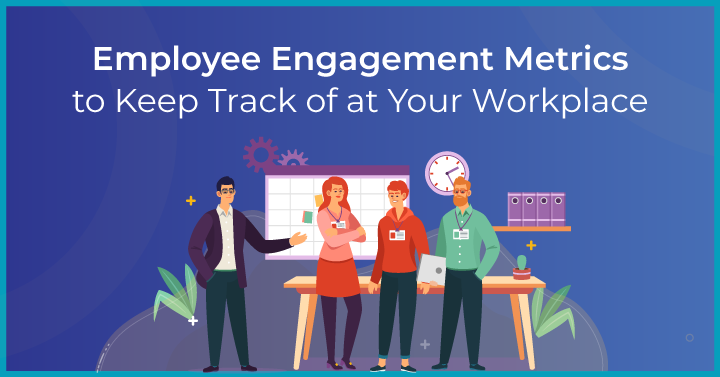One of the most important aspects of a good organization is employee engagement metrics. These metrics help you craft a dynamic and diverse workspace, one where employees are engaged and productive. As per research by Gallup, engaged workers have the capability to outperform their peers by 147%. The million-dollar question here becomes how you create a workspace that keeps employees happy and engaged while still aiming for increased productivity. Companies have found that one of the more effective ways is through increasing employee engagement.
Here are some of the employee engagement metrics that you need to take into account when you are planning to create an employee engagement strategy.
1 What Are Employee Engagement Metrics?
Employee engagement metrics are quantitative measures that help companies track engagement. This is a fundamental concept for companies looking to understand both the qualitative and quantitative relationship that exists between them and their employees.
2 Why Should You Track Employee Engagement Metrics?
In the simplest of terms, these are all different ways through which you can gauge how engaged and invested your employees are with their work and the company as a whole.
Tracking employee engagement metrics is essential to improve factors like retention and performance of employees. Employee engagement has time and again been shown to directly impact factors like profits, customer satisfaction, innovation, and retention. Engaged employees are essential for the continued growth and success of a company.
Measuring employee engagement is not as straightforward as some other metrics. Employee engagement metrics are a combination of happiness, motivation, commitment, and satisfaction, which if you think about it, aren’t as easy to measure, after all, they are all feelings at the end of the day. There are some indicators that have been put in place so that this data can be turned into quantifiable metrics.
3 15 Employee Engagement Metrics to Watch out For!
3.1 Employee Net Provider Score (eNPS)

This particular employee engagement metric is based on Net promoter scores which are used to measure the satisfaction and loyalty of customers. Though with a couple of minor tweaks in the kind of questions asked, progressive employers who are looking to foster an environment that is employee centric rather than customer-centric, have been collecting information about employee engagement as well.
So, how it works is that a simple question is asked like- “How happy are you with your current role?” The employees answer on a scale of 1-10. On this scale anyone answering between 0-6 is termed a detractor, 7 & 8 are termed passive, and finally, 9 & 10 are called promoters. The final employee net provider score is calculated by subtracting the detractors from promoters and then dividing it by the number of respondents.
eNPS = (Promoters - Detractors)
-----------------------------
Total Respondents
3.2 Work-Life Balance
Work-life balance is the amount of workload that an employee has during the week. Also, do check whether or not it can be achieved realistically within working hours. Too much work can lead to burning out which is a big detractor when calculating employee engagement metrics. Burning out is a detractor as it shows that people are exhausted because of work, which leads to low productivity and engagement.
This can be easily resolved by keeping track of the workload amongst the team using timesheets, hour tracking, and employee monitoring software. Constant surveys also help you see whether people are at risk of overwork. This is also how you ensure that the workload is evenly distributed, and employee engagement remains high.
Questions like - “On a scale of 1-10, how would you rate your workload?” help you understand their work-life balance better.
3.3 Professional Development
Growth is the biggest driving force behind employees today. They prioritize learning, making connections, and moving ahead professionally as one of the biggest attractions to any job irrespective of their position. It is the knowledge that they collect from the job that helps them grow further.
Failure to provide your employees with learning development opportunities can lead to the loss of top talent. So how do you measure this? A survey is the best way to do so. Include questions like- “Do you think you receive opportunities to further your talents in the organization?” in your surveys to gauge the workforce better.
3.4 Workplace Recognition
Recognition is another aspect that impacts the overall success of your organization as well as an essential employee engagement metric. A culture of recognition is one where employees are recognized for their contributions which in turn makes them feel valued and perform even better the next time around.
So, how do you measure this particular metric? well, a survey is always helpful. You can design a pulse survey with questions like - “Do you feel valued at work” & “Is recognition given on time” to see where you can improve this aspect of working for your employees.
3.5 Absenteeism
If people take a large number of leaves for no valid reason, then the company has an engagement issue. A team member taking a vacation sets off a chain of events with other employees having to cover for the one who isn’t there, which in turn can hamper their work, thus leading to a bad employee experience.
If this happens once or twice, it's fine, but if absenteeism is a chronic issue in your organization, you need to consider taking steps to manage and streamline work better. A high absenteeism rate has a direct impact on the growth rate as well as both the work, as well as employee morale, gets hampered.
This particular metric is individually calculated for every employee. The most common way to calculate absenteeism is;
Absenteeism rate = Number of absent days
-----------------------------
Number of working days
3.6 Retention Rate

Retention rate refers to the number of people who stay in the organization beyond their notice period. This signals high engagement with the organization. A good retention rate provides two major benefits to the organization. On one hand, it helps keep the recruitment costs down as hiring a new employee is an expensive endeavor and secondly, it keeps productivity high as people fit in and understand the internal process better.
You can calculate the retention rate by;
Retention rate = Total number of employees - Employees who leave
—----------------------------- X 100
Total number of employees
3.7 Work Culture
A good work culture is one that is transparent and inclusive. It allows people to have an open conversation. It is an essential pillar in attracting and retaining employees. This is another factor that is slightly abstract when it comes to changing it into a metric to understand.
The easiest way to do it is with the help of questions like - “Are you happy with the work?” & “Do you find it easy to connect with people socially in the workspace ?” in a survey. These questions will be more along the lines of a yes/no answer, allowing you to compile the data with ease.
3.8 Alignment
Here alignment refers to whether or not an employee can relate to the larger organizational goals. For a company to grow, an employee’s goals need to be in tandem with the organization. This way they will see their work as essential to the organization providing them with an intrinsic motivation to go above and beyond when it comes to accomplishing goals.
A basic survey i.e an employee happiness survey will once again help you understand your employees better. Include questions like- “Do you agree with the organizational values and do you believe they align with your personal values?”
3.9 Compensation and Benefits
Compensation is one of the most basic metrics along which you can judge employee engagement. Employees who are rightly compensated for their job are known to be much more engaged with their work than their underpaid counterparts. In case you are not providing them with fair compensation, you will see a high turnover rate.
But how do you know you are providing the right compensation? There are a couple of ways you can go about this. Always be attuned to the industry average and also the cost of living in your areas. Another way to gauge if you are paying your employees a fair amount is through a survey. Include questions like- “Are you satisfied with the process used to calculate pay in the organization?”
3.10 Employee Performance

Employees who are engaged are bound to work better. So, just a simple assessment of your employee's performance will allow you to have a better understanding of the employee engagement metrics.
There are four aspects you need to check out when looking at employee performance-
- Quality metrics (e.g. number of errors): This refers to the quality of the work being produced.
2. Quantity metrics (sales, units produced): The volume of the work which is dependent on the industry in question.
3. Efficiency metrics: The effort and amount being invested to get the desired results.
4. Organizational metrics (ROI): How well the organization is performing as a whole.
3.11 Employee Satisfaction
Employee satisfaction is an understanding of external factors like the work environment and benefits. A satisfied employee is one who feels that all aspects of their work are in alignment, and they want to put their best foot forward every time.
An easy way to understand employee satisfaction is with the help of a survey. There are two kinds of surveys you can run. The first is a pulse survey that you can send out at regular intervals and the second is an annual survey which is done once a year.
The questions in the survey would be:
- Do you feel your job allows you to use your skills?
- Are you happy with the career path you are on within the company?
- Do you have a healthy working relationship with your manager?
3.12 Autonomy
Having autonomy over work allows employees to have better results. An often overlooked aspect of employee engagement is the manager they are working with, No employee wants to be micromanaged. If they are constantly being nagged about work their focus is not on the quality of work but rather on how to avoid the nagging. This is detrimental to both the employee as well the organization.
So, ensure that you have good managers at the helm of your different departments. This metric can be figured out through surveys. A pulse survey designed to understand the relationship between managers and employees will help you do so.
3.13 Customer Satisfaction
Constantly track your customer satisfaction rates, they are a great indicator of how your employees are doing. High engagement rates will directly reflect in the interactions employees have with customers. A good customer review can be
This metric is not 100% foolproof though. There are going to be times when customers will be happy but employees burnt out, so do approach this one with a certain level of moderation.
3.14 Employer Review Site Ratings
Ratings have a massive impact on what kind of talent to end up attracting to your organization. Before people walk in to do an interview with your organization they will read reviews. Considering Glassdoor is the industry leader in gauging workplace satisfaction. So, keep a look out for these reviews you will be able to gain valuable insights that might not be easy to get otherwise around.
Other employee review sites include Indeed, Career Bliss, Job Advisor, and Job Case
3.15 Employee Engagement Surveys
Finally, if you are looking at employee engagement metrics, you need to talk about employee engagement surveys. These are the most straightforward ways to be able to get the information you are looking for. Once a year doing an annual survey with all the employees and the questions stated above will allow you to understand where you need to improve and where you are doing fine.
4 FAQs
- What are key engagement metrics?
Some key engagement metrics are eNPS, employee satisfaction, retention rate, and absenteeism
- What are the 3 aspects of measuring employee engagement?
As per Kahn, the 3 dimensions of employee engagement are physical, cognitive, and emotional.
- What are the strongest indicators of employee engagement?
The strongest indicators of employee engagement are high retention rate, increased productivity, improved customer service and less absenteeism.
 Interested in Virtual Team Building Events?
Interested in Virtual Team Building Events?





















